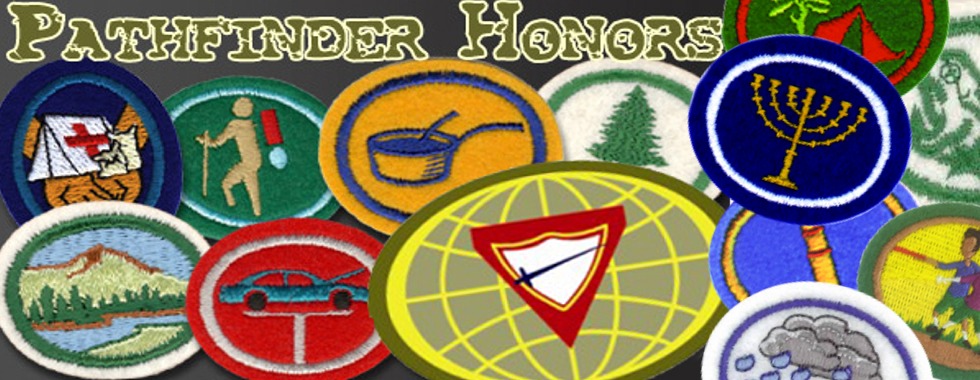
Adventist Youth (AY) Honours are a core portion of the overall Pathfinder curriculum. There are close to 300 AY Honors that can be earned, covering a wide variety of interests, from art to music to vocational pursuits
- Arts Crafts & Hobbies
- Nature
- Recreation
- Health & Science
- Outdoor Industries
- Vocational
- Household Arts
- Outreach Ministries
Arts Crafts & Hobbies
Aboriginal Lore
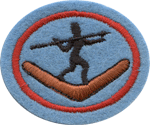
- Category: Arts, Crafts, and Hobbies
- Skill Level: UNK
- Original Honor: UNK
- Adventsource Honors Handbook PDF
Requirements:
- Who are the Aborigines and where did they come from? How many tribes were there when European colonization commenced?
- Discuss the tribal system. What are totems?
- Discuss the food of the Aborigines: a. Kinds b. How obtained c. How prepared
- Discuss their homes. Of what are they made and why are they not permanent? Where do the young men and boys sleep?
- How do they communicate with other tribes who may not understand their language? How do they send signals within the tribe? What is the purpose of the Tjuringa (or Churinga)?
- What are some of the articles of trade and exchange? What domestic utensils do they use.
- Describe some of the weapons used in hunting and warfare.
- What is a corroboree? Explain its purpose. What are clap sticks and the didgeridoo?
- What games to children play? How are young men trained? How are they initiated? What is the bora ground? What is a bull roarer?
- Discuss the two main types of Aboriginal art.
- Briefly relate the history of the Aborigines since the white man arrived in Australia, mentioning the government policies through the years and the work of missions.
African Lore
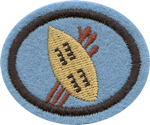
Category: Arts, Crafts, and Hobbies
Skill Level: UNK
Original Honor: UNK
Originating Institution: East African Division
Requirements:
- Be able to name and locate at least ten different African tribes of the present day and name several outstanding features of each.
- a. Select for study an African Tribe. (If you belong to an African Tribe, select one other than your own.)
- b. Find out detailed information on the tribe selected, in the following areas:
- (1) eating habits
- (2) initiation ceremony
- (3) witch doctors
- (4) living and worship conditions
- (5) education
- (6) burials
- (7) money
- (8) dress
- (9) industry
3. Tell an African folk story bringing out its moral.
4. Make a collection of at least 15 object manufactured by African tribes (other than your own).[AdSense-A]
Airplane Modeling
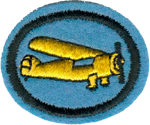
- Category: Arts, Crafts, and Hobbies
- Skill Level: 1
- Original Honor: 1944
- Originating Institution: General Conference
Requirements:
- Build and successfully fly an airplane from a kit made of balsa wood and tissue paper, and rubber band or gas powered.
- Build a balsa wood glider from a kit and observe its flying characteristics as related to the variable positions of the wings.
- Make and successfully fly two different styles of airplanes using sheets of paper between eight (20.3 cm) and fourteen (35.6 cm) inches in width and length.
- Define, locate, and explain the usage of the following basic items:
- a. Fuselage
- b. Wing
- c. Aileron
- d. Rudder
- e. Horizontal stabilizer
- f. Strut
- g. Cockpit
- h. Engine
- i. Landing gear
- j. Propeller
Basketry
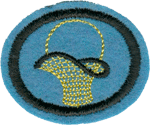
- Category: Arts, Crafts, and Hobbies
- Skill Level: 2
- Original Honor: 1937 Revised 1944
- Originating Institution: General Conference
Requirements:
- Know the names of two countries where Rattan (cane) is grown.
- Explain how to treat pithcane (reed) before weaving.
- What tools would you use for: a. Cane basket making? b. Raffia or Indian basket making?
- Define: a. Weaver singeing b. Crushing
- Explain how to: a. Mend a broken spoke (stake). b. Join a weaving rod (reed).
- Name two kinds of bases used in baskets and tell in which type of basket each one can be used.
- Describe how to lay: a. A footridge border b. A three-rod border
- Do the following: simple weaving, slewing, and bi-spoking, and stitch a raffia base.
- Make a cane sandwich tray with a wood base.
- Make a hot roll basket with a woven base.
- Make a round hot pad six inches (15.2 cm) in diameter in Raffia or Indian basketry.
Block Printing
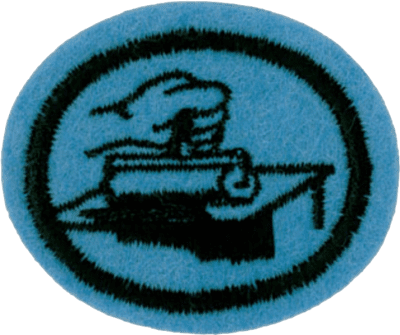
- Category: Arts, Crafts, and Hobbies
- Skill Level: 2
- Original Honor: 1945
- Originating Institution: General Conference
Requirements:
- List the tools and equipment necessary for block printing.
- Write a paragraph on the principles of design and lettering as applied to block printing.
- Using a potato, carve a design incorporating your initials into it, and use it to print your initials on paper.
- Design and print at least one greeting card.
- Design and print one bookplate or book cover.
- Going through the steps of designing, carving, and printing, create another original piece of work of your choice.
Braiding and Advanced
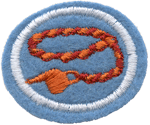
- Category: Arts, Crafts, and Hobbies
- Skill Level: 1
- Original Honor: 1972
- Originating Institution: North American Division
Requirements:
1. Make a three-strand braid, using hair, rope, or cord.
2. Make a zipper pull or a key chain using the four-strand round or square braid.
3. Make a four-strand hanger cover.
4. Make a four-strand round braid lanyard.
5. Know how to start and end all projects.
- Category: Arts, Crafts, and Hobbies
- Skill Level: 2
- Original Honor: 1976
- Originating Institution: North American Division
Requirements:
- Have the Braiding Honor.
- Make a six- or eight-strand zipper pull or key chain.
- Make a six- or eight-strand zipper pull or key chain showing zigzag technique by reversing direction of braid, or make a project showing the three-part inside or trick braid.
- Do one of the following: a. Six-strand lanyard. b. Bookmark using at least six strands. c. Four-strand dog leash using twine or wire for a core to braid around
- Know how to start and end all projects.
Bread Dough

- Category: Arts, Crafts, and Hobbies
- Skill Level: 1
- Original Honor: 1976
- Originating Institution: General Conference
Requirements:
- Make a list of materials and supplies needed for dough artistry.
- Why is it important to have clean hands and use hand lotion while working with bread dough?
- Explain the different techniques of tinting and painting the dough.
- What type of finish do you use to protect and give a glossy appearance?
- Make at least two different flowers with leaves and arrange into a container of your choice.
- Make one of the following using tinted dough: a. Sculpture arrangement. b. Small wall plaque
- Make one of the following: a. Kitchen refrigerator magnet. b. Pin. c. Choice of something you would like to make
Bridges

- Skill Level: 1
- Original Honor: 2012
- Originating Institution: North American Division
Requirements:
1. Define the following terms:
- a.Bridge
- b.Aqueduct
- c.Falsework
- d.Compression force
- e.Tension force
- f.Bascule bridge
- g.Covered bridge
2.Describe these six main types of bridge design and give two examples of each:
- a.Arch bridge
- b.Beam bridge
- c.Cable-stayed bridge
- d.Cantilever bridge
- e.Suspension bridge
- f.Truss bridge
3. Discover the distance each of the following bridge designs can span:
- a. Arch bridge
- b.Beam bridge
- c.Cable-stayed bridge
- d.Cantilever bridge
- e.Suspension bridge
- f.Truss bridge
4.Name the bridge design that can span the longest distance
5.Draw or illustrate the basic design of each of the following bridge types.
- a.Beam bridge
- b.Arch bridge
- c.Suspension bridge
- d.Covered bridge
- e.Truss bridge
- f.Cable-stayed bridge (fan shape)
- g.Cantilever bridge
- h.Bascule bridge
- i.Cable-stayed bridge (harp shape)
6.Do the following activities:
- a.Watch a video about bridges.
- b.Make a list of at least eight notable bridges OR name two bridges that you have crossed and tell what design they are.
7.Make a video/multimedia presentation or scrapbook presentation about bridge(s) you have seen.
8.Build a bridge using materials such as craft sticks, toothpicks, yarn, thread, and glue.
9.Recite John 3:16, then tell how this verse describes Jesus’ role as a bridge between heaven and earth.[AdSense-A]
Cake Decorating
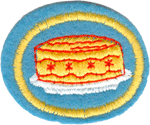
- Category: Arts, Crafts, and Hobbies
- Skill Level: 1
- Original Honor: 1972
- Originating Institution: General Conference
Requirements:
- 1. List equipment necessary for cake decorating.
- 2. Learn from memory the two cake icings-butter cream and royal-and their proper uses. Name one other icing used for frosting.
- 3. Learn and demonstrate proper construction of the decorating tube using parchment, wax papers, or a disposable bag. Show proper method of inserting tip, brushing with color, filling with icing, and folding of top. What is the name of the top fold?
- 4. Name three essential steps to good cake decorating.
5. Demonstrate pressure control with tubes. Learn the technique and name the proper tip (tube) used to make the following:
- a. Star, fill-in and border
- b. Rosette
- c. Shell border
- d. “S” design
- e. Ribbon
- f. Zigzag border
- g. Leaves
6. Name four color techniques. Demonstrate two, including two-color icing.
7. Learn to make the following flowers:
- a. Sweet pea
- b. Rosebud
- c. Full American beauty rose
- d. Drop flower
8. Demonstrate writing technique using two different tips and methods.
9. Decorate a doll cake or a cake prepared in a specialty cake pan using star fill-in method. Use at least two colors to make the design or pattern.
10. Make a special occasion cake of your choice using two or more borders of different types, and a floral arrangement.
11. Make a heart cake using borders, florets, string work, and writing
Candlemaking
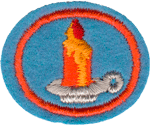
- Category: Arts, Crafts, and Hobbies
- Skill Level: 1
- Original Honor: 1972
- Originating Institution: General Conference
Requirements:
1. Make at least five of the following:
- a. Free-form sand candle
- b. Layered colored candle
- c. Candle made in a mold
- d. Ice candle
- e. Dipped candle
- f. Dribble-wax candle
- g. Perfumed candle
- h. Pair of beeswax candles
- i. Floating candle
- j. Candle in a container/jar
- k. Decorated candle
2. Know the two kinds of wax used for candle making and their uses.
3. Know sizes of wicking and which one will burn properly in each particular candle.
4. When should a metal core wick be used?
5. Know the safety techniques of candle making.
Card Making

- Category: Arts, Crafts, and Hobbies
- Skill Level: 1
- Original Honor: 2010
- Originating Institution: North American Division
Requirements:
1. How are the following supplies used in card making?
- a. card stock
- b. felt pens
- c. scissors (regular and decorative)
- d. embellishments
- e. rubber stamps
- f. water pencils & crayons
- g. ink pads
- h. punches
2. Describe how at least three different kinds of paper are used in card making, such as glossy card stock, corrugated paper, mulberry paper, vellum, or gift wrap.
3. Describe four methods of coloring in a stamped image and emonstrate at least two of them.
4. Name four different types of ink pads and describe how they are used. Demonstrate proficiency in using at least two of them in a practice project.
5. What is meant by the term monochromatic?
6. What is sponging, and how do you use it in card making?
7. What is dry embossing and what tools do you need for this technique?
8. Demonstrate proper care and cleaning of rubber stamps and storing of ink pads.
9. Describe and demonstrate how to use at least two of the following in a practice project.
- a. foam dots (also squares, hexagons, etc.)
- b. foam tape
- c. double sided tape
- d. tape runners
- e. zots
10. List at least five reasons for making cards.
11. Make cards to fulfill three of the reasons discovered in requirement 10. During your card creation, demonstrate at least three of the following techniques:
- a. Monochromatic style
- b. sponging
- c. two types of coloring in a stamped image
- d. a card using at least two types of paper
- e. a card using embellishments, foam tape/dots, or other supplies mentioned in requirement 5.
- f. A card using a method of your choice
12. Do the following:
- a. Display your cards at a Pathfinder, AY, youth group, or similar event.
- b. Give at least one of your cards to someone else as part of a missions, share your faith, or similar outreach/caring event
13. Read the following passages (preferably with a group/unit) and discuss the similarities / differences between these letter greetings and modern day greeting cards.
- a. 1 Corinthians 15:58
- b. Ephesians 6:21
- c. Philippians 4:1
- d. James 1:16, 19
- e. Philemon 1:1
Ceramics

- Category: Arts, Crafts, and Hobbies
- Skill Level: 2
- Original Honor: 1956
- Originating Institution: NAD/ General Conference (link here for GC version of honor requirements)
Requirements (NAD):
1. Tell briefly the history of early ceramics.
2. Know what is meant by the following terms:
- a. Greenware
- b. Bisque
- c. Decal
- d. Kiln
- e. Glaze
- f. Slip
- g. Mender
- h. Stain
3. Explain the use of cones in kilns.
4. Know how and when to use underglaze, glaze and stain.
5. Know what tools are used in completing your projects in ceramics.
6. Know the difference between glaze and food-safe glaze.
7. Complete two of the following using underglaze on one item, and food-safe glaze on the second item:[AdSense-A]
- a. Cookie jar
- b. Pie plate
- c. Vase
- d. Flower planter
- e. Candy dish
- f. Mug
- g. Item of your choice
Note: Candidate need not do the firing.
Copper Enameling

- Category: Arts, Crafts, and Hobbies
- Skill Level: 1
- Original Honor: 1972
- Originating Institution: North American Division
Requirements:
- Know the difference between low-temp and high-temp enameling.
- Name the materials on which the low-temp process can be used.
- What is the proper method of cleaning items to be enameled? Why is it important to clean items to be enameled?
- How is copper finished to prevent tarnishing?
- Name the tools used in enameling.
- What heat sources can be used for low-temp enameling? What safety precautions should be followed?
- How are pin backs and magnets attached to the back of metal pieces?
- Make at least five items using the following techniques:
- a. Swirling
- b. Stencil
- c. Threads
- d. Mosaic
- e. Scraffito
NOTE: The high-fire firing for this honor need not be done by the candidate. This honor may be earned using either the high-fire or the low-fire enameling.
Copper Enameling, Advanced
 Category: Arts, Crafts, and Hobbies
Category: Arts, Crafts, and Hobbies- Skill Level: 3
- Original Honor: 1972
- Originating Institution: North American Division
Requirements:
- Have the Copper Enameling Honor.
- Explain the use of a trivet.
- What materials can be used to decorate enameled pieces for the applique technique?
- Use four of the following techniques in completing requirement 5:
- a. Counter enameling
b. Applique
c. Cloisonne
d. Dry painting
e. Scraffito
5. Make four of the following projects:
- a. Holiday decoration
b. Kitchen decoration
c. Foil flower
d. Pin or stick pin
e. Metal bookends
f. Metal switch plate
g. Three-dimensional item
h. Similar item of your choice
Counted Cross Stitch
 Category: Arts, Crafts, and Hobbies
Category: Arts, Crafts, and Hobbies- Skill Level: 2
- Original Honor: 1986
- Originating Institution: General Conference
Requirements:
- Have a tote with cross-stitch materials, including at least one hoop, masking tape or Fra-check, needles, and scissors.
- What is the difference between cross-stitching, counted cross-stitch, and embroidery?
- Know at least four stitches used in counted cross-stitch.
- Cross-stitch a simple object in three different sizes of aida cloth. Mount and label the size and name of aida cloth used, stating how many floss strands are to be used with each.
- Make a counted cross-stitch of a quote with a border and frame it for hanging, using at least three different stitches.
- Make at least a 5 x 7 inches (12.7 x 17.8 cm) counted cross-stitch on aida-14 of a nature scene.
Crocheting

- Category: Arts, Crafts, and Hobbies
- Skill Level: 2
- Original Honor: 1970
- Originating Institution: General Conference
Requirements:
- Define and crochet the following: ST, SP, STS, RND, INCL, DEC, and INC.
- Make squares of at least 20 stitches of the following: SC, DC, HDC, TR, and DTR.
- Show how to measure stitch gauge or row gauge on sample squares.
- Know how to care for items made out of wool, orlon, nylon, and cotton.
- Know how to make a granny square, and show something you have made using a granny square, such as a hat, scarf, pillow cover, etc.
- Show a sample of simple edging you have made out of thread.
- Crochet one of the following out of yarn: hat, scarf, sleeveless sweater, or slippers.
Crocheting, Advanced

- Category: Arts, Crafts, and Hobbies
- Skill Level: 3
- Original Honor: 1970
- Originating Institution: General Conference
Requirements:
- Have the Crocheting Honor.
- Crochet a round doily out of thread.
- Make a fancy hairpin lace for a pillow case or similar object.
- Crochet a sweater (not sleeveless) or baby set.
- Crochet an afghan or a throw rug.
Currency (Coins)

- Skill Level: 2
- Original Honor: 1945
- Originating Institution: General Conference
Requirements:
- Relate briefly the story of barter, showing three reasons why money came into being and naming at least ten strange forms of money used in place of coins or currency.
- Relate briefly the history of coinage and paper currency in your country, making sure to mention the dates of the establishment of any mints or engraving plants. Also discover some change in the metal composition of a coin, giving any interesting highlights concerning such a change.
- Explain how money is distributed in your country.
- Define the following terms:
- a. Alloy k. Mint Mark
- b. Altered Date l. Obverse
- c. Buffed Coins m. Planchet
- d. Cast Coins n. Proof
- e. Clad Coinage o. Reeded Edge
- f. Commemorative p. Reverse
- g. Die q. Series
- h. Field r. Type
- i. Inscription s. Whizzed Coins
- j. Lettered Edge t. Wire Edge
5. Describe the obverse and reverse for paper money of the six lowest denominations currently in use in your country.
6. Know how coins are graded in quality by collectors.
7. Collect and mount a type set of coins from your country of any date currently being minted or in circulation. Proof, commemorative, rare, silver, or expensive coins are not needed. In your collection:
- a. Possess at least one coin from each mint in the type set.
- b. Locate and identify the mint mark (if any) on each coin.
- c. Locate and identify the initials (if any) of each coin’s designer(s).
8. Do two of the following:
- a. Make enlarged drawings of both sides of ten different denominations or forms of coins for your country no longer in circulation.
- b. Collect, identify, and mount 25 different foreign coins. No two coins alike.
- c. Collect and mount a type set of coins from your country minted during the 20th Century.
- d. Collect and mount a date set of series of coins for your country beginning with your birth year. (Commemorative, gold, proof, expensive, or rare coins need not be included.)
Note: Facts About United States Money (free), Office of the Secretary of the Treasury, U.S. Treasury Department, Washington, D.C. 20025.
Facts about your country’s currency may be obtained from the government treasury department..[AdSense-B]
Currency (Coins), Advanced

- Skill Level: 3
- Original Honor: 1998
- Originating Institution: General Conference
Requirements
- Have the Currency (Coins) Honor
- Select a coin or note from your collection and present an oral or written report on the historical or other significance of the person(s), place(s), item(s) or symbol(s) found on both sides.
- What are the laws regarding counterfeiting in your country and what devices are used in your nation’s currency to prevent it?
- Attend a meeting of a local coin club and report on your experience. Possible items to consider:
- a. Level of expertise of members as demonstrated by presentations and dialogues.
- b. Average general age of attendees.
- c. Ideas which might help the club extend its collector interest to a wider audience.
- d. How newcomer friendly is the organization.
- e. Suggestions on how these people might be reached with the gospel through a manner which they would find attractive.
5. Select one of the three categories of your collection as required under the Currency Honor requirements 7 and 8, and increase your collection to include twice the total number of specimens.
6. Add to your collection at least one of the unusual (odd and curious) forms learned about in requirement 1 of the Currency Honor requirements and have in your Currency Honor files, at least a paragraph summarizing how, when and where this item was used as currency.
Decoupage
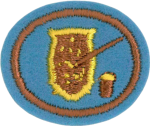
- Skill Level: 1
- Original Honor: 1975
- Originating Institution: General Conference
Requirements:
- Give the meaning and history of decoupage
- Make a list of the materials and equipment needed in decoupage.
- Describe how to prepare a wood or metal object for decoupage.
- Describe three ways in which a print may be used in decoupage.
- Use the basic steps in completing two of the following objects:
- a. Modpodge print
- b. Keyring
- c. Bookends
- d. Bottle
- e. Tissue box
- f. Reasonable choice
Adventist Youth Ministries
YPAC North American Division Youth & Young Adult Ministries
Digital Photography

- Category: Arts, Crafts, and Hobbies
- Skill Level 2
- Original Honor 2007
- Originating Organization: North American Division
Requirements:
1. Explain the following:
- a. What are the principles of digital camera construction and how a digital camera works?
- b. What are the effect of light on an image sensor?
- c. How color images are created from the BW image the sensor captures?
- d. What the camera lens does; what focal length means?
- e. How are lens aperture and depth of field related?
- f. Describe pixels, image resolution, and image size?
- g. What are the two types of image compression?
2. Name and describe three types of image formats.
3. Give the principle uses of photography:
4. Take pictures illustrating at least eight of the following techniques. Use comparison pictures for illustration.[AdSense-B]
- a. Framing
- b. Camera Steadiness
- c. Direction of lighting – front, side, or backlighting
- d. Quality of light – shade, sunlight, and time of day
- e. Rule of thirds
- f. Angle – eye level, high and low level
- g. Level horizon
- h. Distance from subject – fill the frame
- i. Use of leading lines
- j. Correct exposure – underexposed, overexposed, and correctly exposed
- k. Use of flash – proper distance and reflective objects
5. Learn how to place photos in a media software slideshow program. Create a media presentation showing the pictures you took using the above techniques.
6. Using a photo editing program on a computer, show ability to crop, color correct, sharpen, and adjust rightness/contrast to photos.
7. Complete at least three creative photographic projects in a photo editing program; such as a CD cover, a photo scrapbook page, a collage, etc.
8. Have a basic understanding of file organization techniques.
Drawing

- Skill Level: 2
- Original Honor: 2013 (Originally part of GC Honor Drawing and Painting)
- Originating Institution: North American Division
Requirements:
- Make a list of Drawing Media.
- What is Chiaroscuro? And what effect does it have on drawing?
- Draw a Value Scale with at least 10 different values.
- What is the best way to begin drawing until you are sure all sizes, placement and proportions are correct?
- Know the difference between eye level, bird’s eye view and worm’s eye view.
- Show foreground, middle ground and background in a simple landscape.
- What is a “multi-media” drawing?
- Explain Linear Perspective and list at least 4 ways to achieve it when drawing a landscape.
- Draw a cylindrical object and a rectangular object grouped together a little below the eye, showing proper perspective, light and shade.
- Understand and describe these types of subject matter:
- a.Portraits
- b.Landscapes
- c.Still Life
- d.Abstract
11.Draw an animal using simple shapes such as squares, triangles, rectangles.
12.Make a freehand sketch of an animal, showing in values the distribution of color.
13.Make a drawing of some landscape near your home.
14.Draw and shade in a still life. Make it personal and interesting; add personal touches and objects that you are excited about…this will make your artwork more fun and easier for you to finish.
15.Memorize Psalm 33:6, and discuss how it relates to drawing.
Drawing, Advanced

- Skill Level: 3
- Original Honor: 2013 (Originally part of Drawing and Painting)
Originating Institution: North American Division
Requirements:
- Have the Drawing honor.
- Who was Albret Durer and what was his contribution to drawing?
- Give 3 examples of contemporary Artists known for their drawing skills.
- Draw a landscape using multi-media.
5.Using 3 different media for each, draw 3 of the following:
- a.Still Life
- b.Landscape
- c.Cityscape
- d.Seascape
- e.Portrait
6.Choose one of the subjects in #5, and create a drawing at least 12 x 18” in pencil. Concentrate on good perspective and depth. Then, using pencil, shade in your work with a minimum of 6-8 changes in value. Be sure to sign your work. When finished, display your work in a public venue.
7.Memorize Psalm 104:24. Discuss how this verse relates to your drawing and how can it inspire your future works of art.
Duct Tape
 Skill Level: 1
Skill Level: 1- Category: Arts, Crafts, & Hobbies
- Original Honor: 2016
- Originating Institution: North American Division
Requirements:
- List or explain the components of duct tape.
- Give a 3-5 minute report or create a timeline about the history and development of duct tape.
- Name three uses of duct tape.
- List at least three ways that duct tape is used in a professional setting.
- Outline duct tape safety rules as they relate to general duct tape usage, usage recreationally among young people, and in a craft setting.
- Demonstrate the ability to tear pieces of duct tape, by hand, in the following lengths without the aid of a knife, scissors, or any other cutting instrument. The tape must
not get tangled up or wrinkled.
- a. 15 cm (6 inches)
- b. 60 cm (2 feet)
- c. 150 cm (5 feet)
7. Create a toolkit with the basic items needed for duct tape crafts, including at least three colors/designs of duct tape, a cutting mat, scissors, a utility knife, and tools for
residue removal. Demonstrate the ability to use each tool.
8. Create five items from duct tape such as:
- a. Wallet or purse
- b. Basket or tote
- c. A wearable piece of clothing
- d. Holiday decorations
- e. Christmas wrapping or bows
- f. Simple flower arrangement
- g. Toy
- h. Item of your choice
9. Build a boat that will float a 2 kg (5 lb) sack of flour for five minutes while preventing the flour from getting wet. You may use other materials to create a frame,
but the majority of the hull should be made from duct tape.
10. Complete the following spiritual lessons on the “stickiness” of duct tape:
- a. Read Daniel chapter 3 and discuss how duct tape can apply to God and the Hebrews in the story.
- b. Memorize and recite Proverbs 18:24 and explain how duct tape applies to this verse.
- c. Discuss in a group how sin can “stick” to you.
- d. Memorize and recite James 4:7 and share your ideas on how sin can get unstuck in our lives.

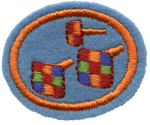 Category: Arts, Crafts, and Hobbies
Category: Arts, Crafts, and Hobbies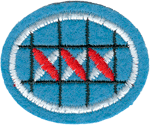 Category: Arts, Crafts, and Hobbies
Category: Arts, Crafts, and Hobbies
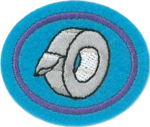 Skill Level: 1
Skill Level: 1

